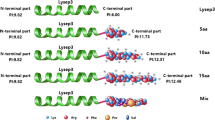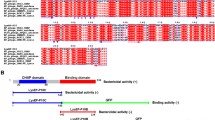Abstract
Multidrug-resistant Escherichia coli has seriously threatened antibiotic resources and international public health. Bacteriophage lysin preparations have been widely considered as valid agents for solving multidrug resistances. Many lysins have been derived to treat diseases caused by Gram-positive bacteria, but only a few lysin preparations have been found that successively treat diseases caused by Gram-negative bacteria. The outer membrane of Gram-negative bacteria effectively blocks the interactions between peptidoglycan in the periplasmic space and bacteriophage lysins, which therefore hampers the antimicrobial effects of bacteriophage lysins. In this study, a new fusion protein (Colicin-Lysep3) was constructed by fusing the translocation and receptor binding domains of colicin A with an E. coli phage lysin, which endows Colicin-Lysep3 bactericidal activity against E. coli from outside of Gram-negative bacteria. These results show that Colicin-Lysep3 could lyse the E. coli broadly in vitro and significantly reduce the number of E. coli in an intestinal infection mouse model. Overall, our findings first demonstrated that a colicin A fragment could enable a bacteriophage lysin to lyse E. coli from the outside, promoting the application of phage lysin preparations in control of Gram-negative bacteria.






Similar content being viewed by others
References
Bardhan P, Faruque AS, Naheed A, Sack DA (2010) Decrease in Shigellosis-related deaths without Shigella spp.-specific interventions. Asia. Emerg Infect Dis 16:1718–1723
Braun V, Pilsl H, Gross P (1994) Colicins: structures, modes of action, transfer through membranes, and evolution. Arch Microbiol 161:199–206
Briers Y, Lavigne R (2015) Breaking barriers: expansion of the use of endolysins as novel antibacterials against Gram-negative bacteria. Future Microbiol 10:377–390
Briers Y, Walmagh M, Van Puyenbroeck V, Cornelissen A, Cenens W, Aertsen A, Oliveira H, Azeredo J, Verween G, Pirnay JP, Miller S, Volckaert G, Lavigne R (2014) Engineered endolysin-based “Artilysins” to combat multidrug-resistant gram-negative pathogens. MBio 5:e01379-14
Cascales E, Buchanan SK, Duché D, Kleanthous C, Lloubès R, Postle K, Riley M, Slatin S, Cavard D (2007) Colicin biology. Microbiol Mol Biol Rev 71:158–229
Cheng Q, Nelson D, Zhu S, Fischetti VA (2005) Removal of group B streptococci colonizing the vagina and oropharynx of mice with a bacteriophage lytic enzyme. Antimicrob Agents Chemother 49:111–117
Defraine V, Schuermans J, Grymonprez B, Govers SK, Aertsen A, Fauvart M, Michiels J, Lavigne R, Briers Y (2016) Efficacy of Artilysin Art-175 against resistant and persistent Acinetobacter baumannii. Antimicrob Agents Chemother 60:3480–3488
Dehkordi FS, Yazdani F, Mozafari J, Valizadeh Y (2014) Virulence factors, serogroups and antimicrobial resistance properties of Escherichia coli strains in fermented dairy products. BMC Res Notes 7:217
Drulis-Kawa Z, Majkowska-Skrobek G, Maciejewska B (2015) Bacteriophages and phage-derived proteins–application approaches. Curr Med Chem 22:1757–1773
Fischetti VA (2008) Bacteriophage lysins as effective antibacterials. Curr Opin Microbiol 11:393–400
Knibiehler M, Howard SP, Baty D, Geli V, Lloubès R, Sauve P, Lazdunski C (1989) Isolation and molecular and functional properties of the amino-terminal domain of colicin A. Eur J Biochem 181:109–113
Lazdunski CJ, Bouveret E, Rigal A, Journet L, Lloubès R, Bénédetti H (1998) Colicin import into Escherichia coli cells. J Bacteriol 180:4993–5002
Lazdunski C, Bouveret E, Rigal A, Journet L, Lloubès R, Bénédetti H (2000) Colicin import into Escherichia coli cells requires the proximity of the inner and outer membranes and other factors. Int J Med Microbiol 290:337–344
Lim JA, Shin H, Kang DH, Ryu S (2012) Characterization of endolysin from a Salmonella Typhimurium-infecting bacteriophage SPN1S. Res Microbiol 163:233–241
Loeffler JM, Nelson D, Fischetti VA (2001) Rapid killing of Streptococcus pneumoniae with a bacteriophage cell wall hydrolase. Science 294:2170–2172
Lood R, Winer BY, Pelzek AJ, Diez-Martinez R, Thandar M, Euler CW, Schuch R, Fischetti VA (2015) Novel phage lysin capable of killing the multidrug-resistant gram-negative bacterium Acinetobacter baumannii in a mouse bacteremia model. Antimicrob Agents Chemother 59:1983–1991
Lukacik P, Barnard TJ, Buchanan SK (2012a) Using a bacteriocin structure to engineer a phage lysin that targets Yersinia pestis. Biochem Soc Trans 40:1503–1506
Lukacik P, Barnard TJ, Keller PW, Chaturvedi KS, Seddiki N, Fairman JW, Noinaj N, Kirby TL, Henderson JP, Steven AC, Hinnebusch BJ, Buchanan SK (2012b) Structural engineering of a phage lysin that targets gram-negative pathogens. Proc Natl Acad Sci USA 109:9857–9862
Lv M, Wang S, Yan G, Sun C, Feng X, Gu J, Han W, Lei L (2015) Genome sequencing and analysis of an Escherichia coli phage vB_EcoM-ep3 with a novel lysin, Lysep3. Virus Genes 50:487–497
Ma Q, Guo Z, Gao C, Zhu R, Wang S, Yu L, Qin W, Xia X, Gu J, Yan G, Lei L (2017) Enhancement of the direct antimicrobial activity of Lysep3 against Escherichia coli by inserting cationic peptides into its C terminus. Antonie Van Leeuwenhoek 110:347–355
Majeed H, Gillor O, Kerr B, Riley MA (2011) Competitive interactions in Escherichia coli populations: the role of bacteriocins. ISME J 5:71–81
Moradpour Z, Ghasemian A (2011) Modified phages: novel antimicrobial agents to combat infectious diseases. Biotechnol Adv 29:732–738
Morlon J, Lloubes R, Chartier M, Bonicel J, Lazdunski C (1983a) Nucleotide sequence of promoter, operator and amino-terminal region of caa, the structural gene of colicin A. EMBO J 2:787–789
Morlon J, Lloubès R, Varenne S, Chartier M, Lazdunski C (1983b) Complete nucleotide sequence of the structural gene for colicin A, a gene translated at non-uniform rate. J Mol Biol 170:271–285
Nandanwar N, Janssen T, Kühl M, Ahmed N, Ewers C, Wieler LH (2014) Extraintestinal pathogenic Escherichia coli (ExPEC) of human and avian origin belonging to sequence type complex 95 (STC95) portray indistinguishable virulence features. Int J Med Microbiol 304:835–842
Narciso-da-Rocha C, Manaia CM (2016) Multidrug resistance phenotypes are widespread over different bacterial taxonomic groups thriving in surface water. Sci Total Environ 563–564:1–9
Nelson D, Loomis L, Fischetti VA (2001) Prevention and elimination of upper respiratory colonization of mice by group A streptococci by using a bacteriophage lytic enzyme. Proc Natl Acad Sci USA 98:4107–4112
Oliveira H, Vilas Boas D, Mesnage S, Kluskens LD, Lavigne R, Sillankorva S, Secundo F, Azeredo J (2016) Structural and enzymatic characterization of ABgp46, a novel phage endolysin with broad anti-gram-negative bacterial activity. Front Microbiol 7:208
Pavlickova S, Klancnik A, Dolezalova M, Mozina SS, Holko I (2017) Antibiotic resistance, virulence factors and biofilm formation ability in Escherichia coli strains isolated from chicken meat and wildlife in the Czech Republic. J Environ Sci Health B 11:1–7
Pires DP, Vilas Boas D, Sillankorva S, Azeredo J (2015) Phage therapy: a step forward in the treatment of Pseudomonas aeruginosa infections. J Virol 89:7449–7456
Plotka M, Kaczorowska AK, Morzywolek A et al (2015) Biochemical characterization and validation of a catalytic site of a highly thermostable Ts2631 endolysin from the thermus scotoductus phage vB_Tsc2631. PLoS ONE 10:e0137374
Qadir MI (2015) Review: phage therapy: a modern tool to control bacterial infections. Pak J Pharm Sci 28:265–270
Sande-Bruinsma NVD, Grundmann H, Verloo D, Tiemersma E, Monen J (2008) Antimicrobial drug use and resistance in Europe. Emerg Infect Dis 14:1722–1730
Thandar M, Lood R, Winer BY, Deutsch DR, Euler CW, Fischetti VA (2016) Novel engineered peptides of a phage lysin as effective antimicrobials against multidrug-resistant Acinetobacter baumannii. Antimicrob Agents Chemother 60:2671–2679
Turner SM, Scott-Tucker A, Cooper LM, Henderson IR (2006) Weapons of mass destruction: virulence factors of the global killer enterotoxigenic Escherichia coli. FEMS Microbiol Lett 263:10–20
Walmagh M, Boczkowska B, Grymonprez B, Briers Y, Drulis-Kawa Z, Lavigne R (2013) Characterization of five novel endolysins from Gram-negative infecting bacteriophages. Appl Microbiol Biotechnol 97:4369–4375
Yan M, Baran PS (2016) Drug discovery: fighting evolution with chemical synthesis. Nature 533:326–327
Young R, Gill JJ (2015) MICROBIOLOGY. phage therapy redux–What is to be done? Science 350:1163–1164
Funding
The study was supported by funds from the National Key Basic Research Program of China (No. 2013CB127205).
Author information
Authors and Affiliations
Corresponding author
Ethics declarations
Conflict of interest
The authors declare that they have no competing interests.
Ethical approval
Mice were purchased from the Animal Experiment Center of Jilin University. All animal research was conducted according to the experimental practices and standards approved by the Animal Welfare and Research Committee at Jilin University (Approval ID: 20100926-1).
Rights and permissions
About this article
Cite this article
Yan, G., Liu, J., Ma, Q. et al. The N-terminal and central domain of colicin A enables phage lysin to lyse Escherichia coli extracellularly. Antonie van Leeuwenhoek 110, 1627–1635 (2017). https://doi.org/10.1007/s10482-017-0912-9
Received:
Accepted:
Published:
Issue Date:
DOI: https://doi.org/10.1007/s10482-017-0912-9




